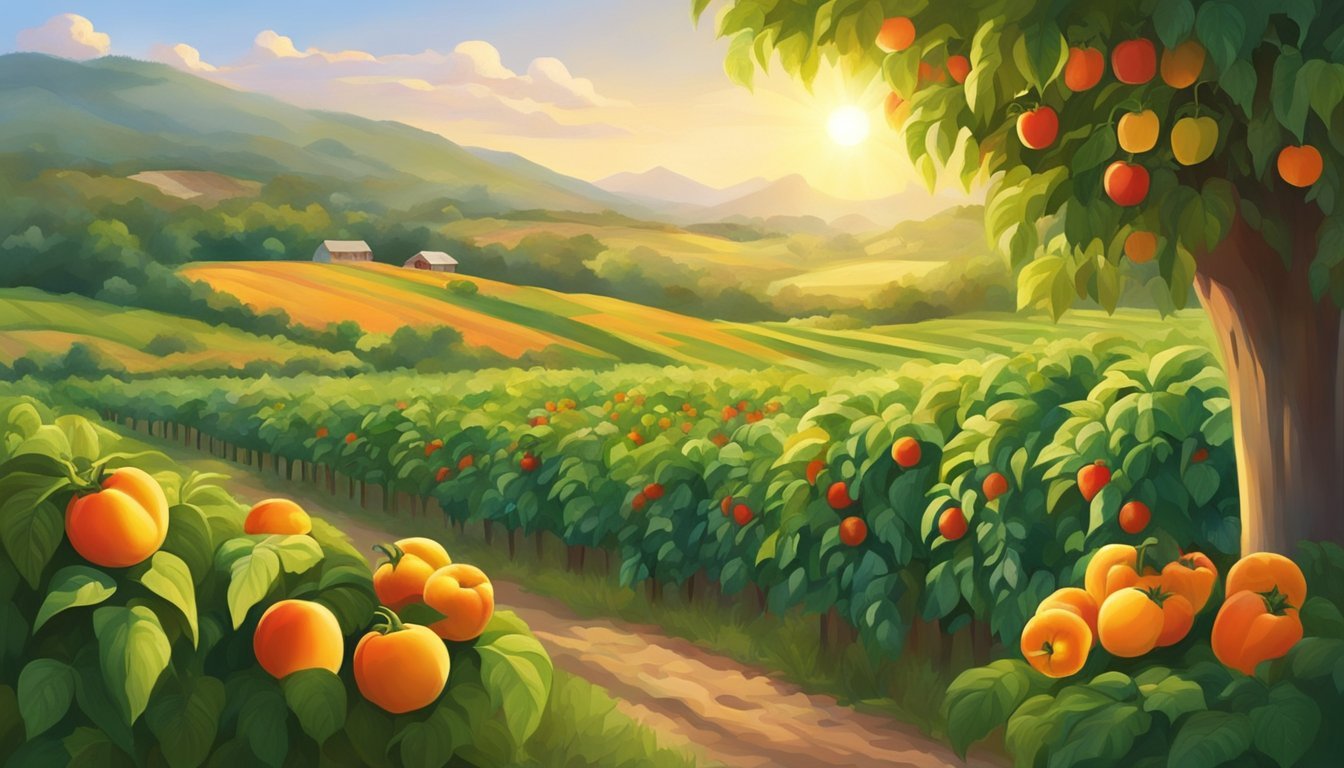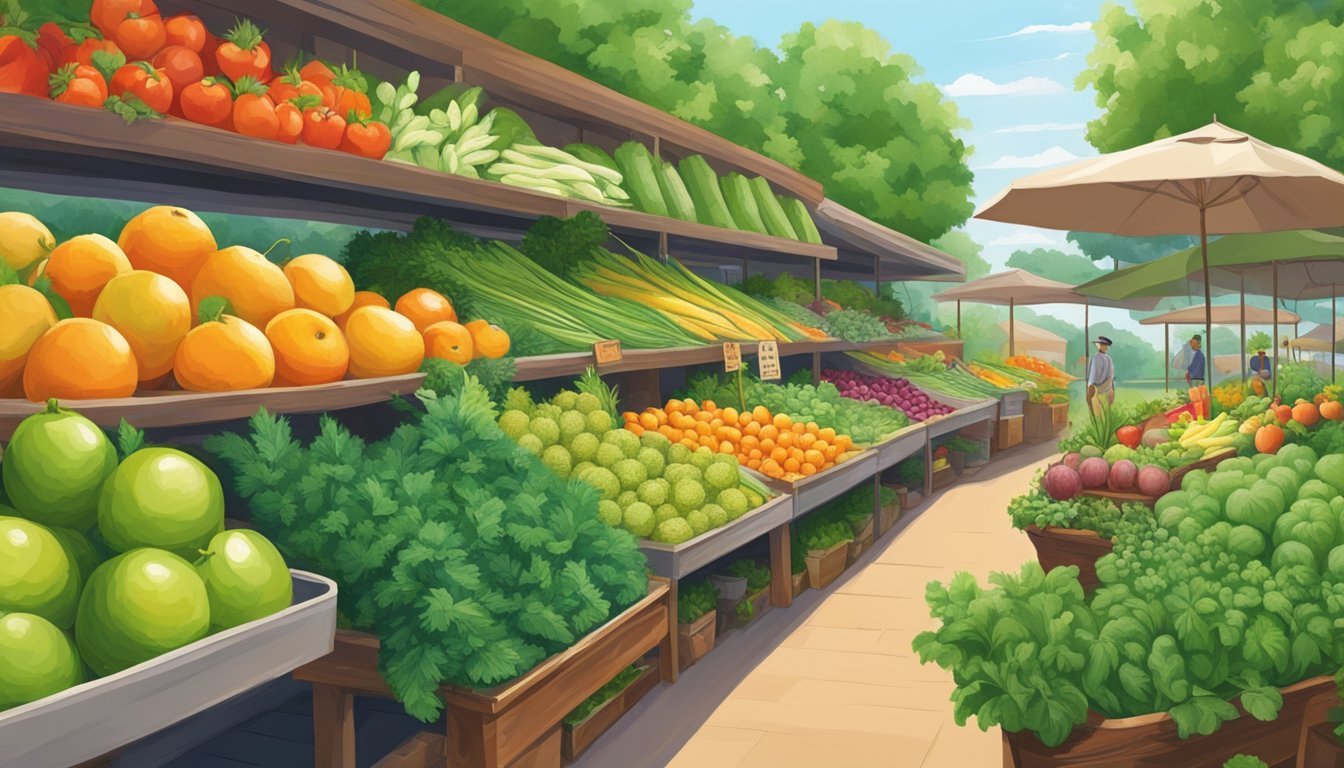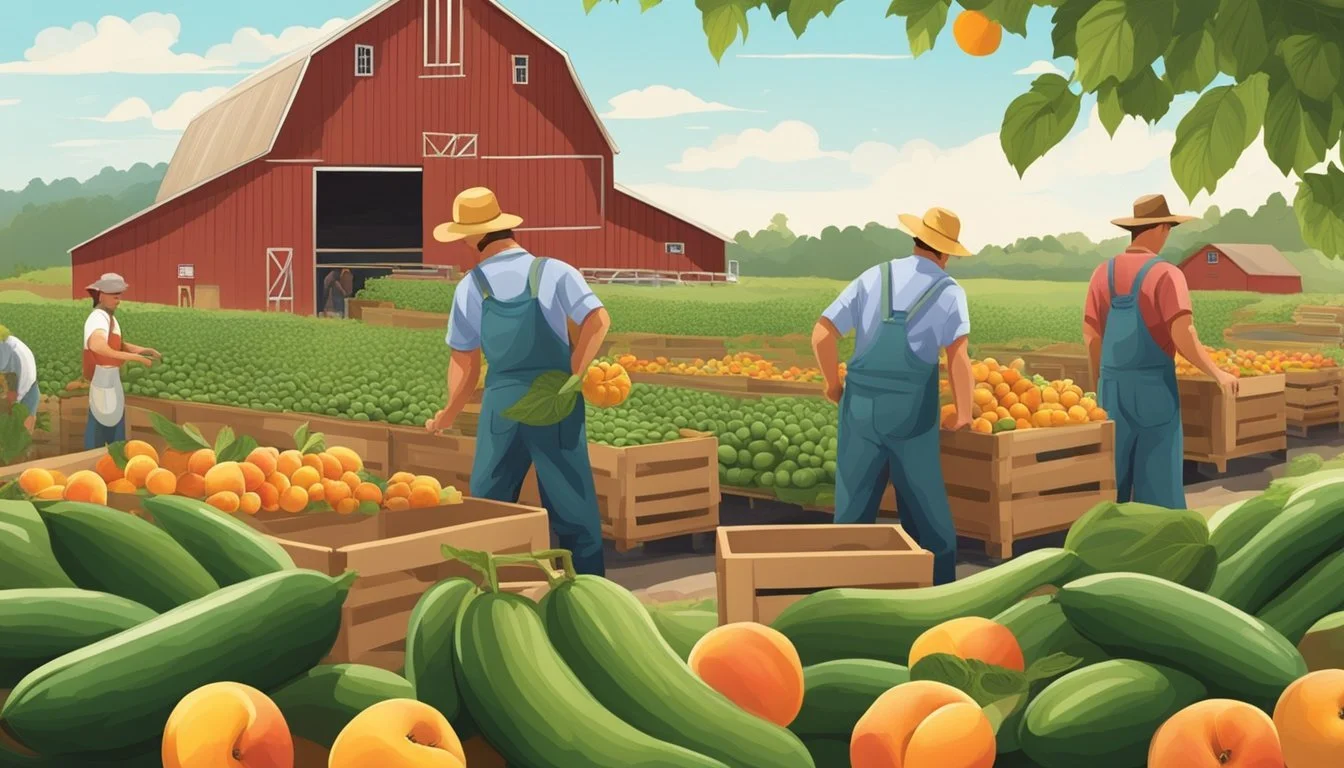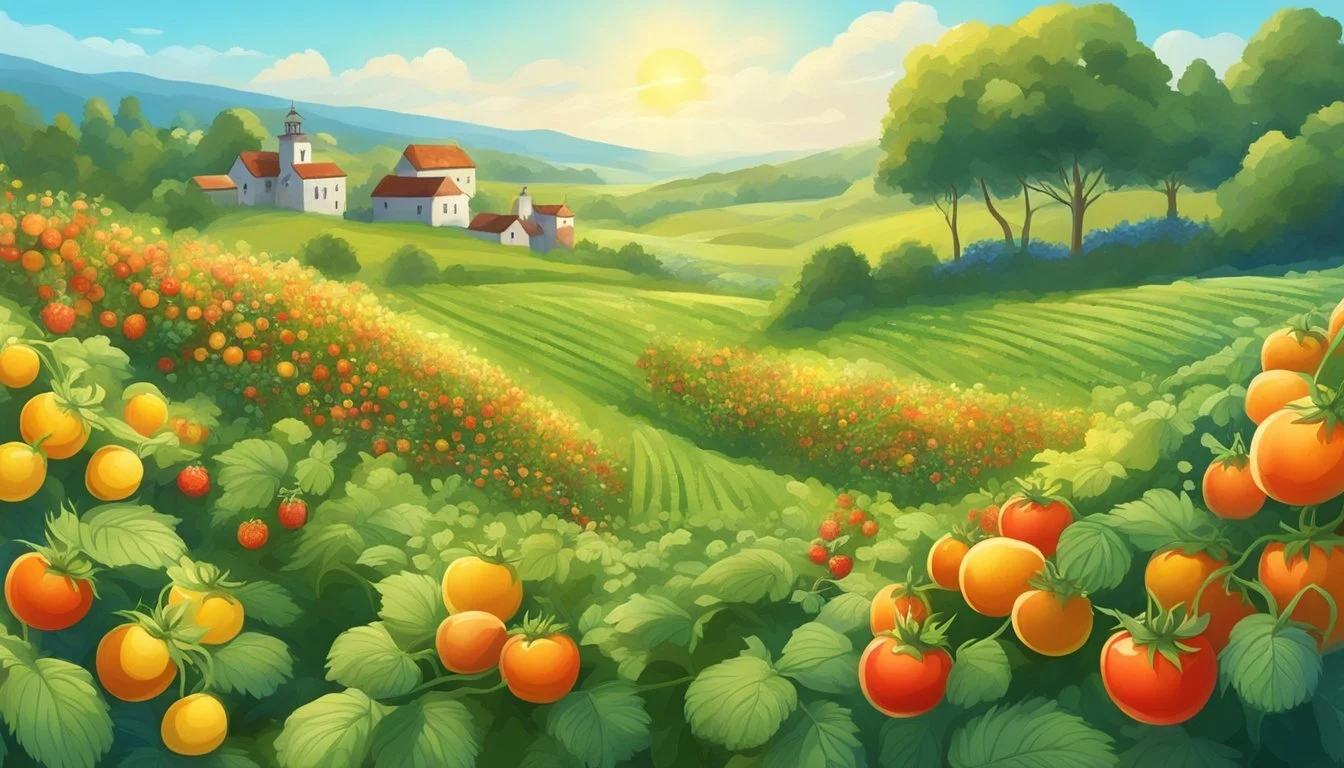Oklahoma Seasonal Fruit & Vegetables in June
Your Fresh Picks Guide
This Article is Part of our Oklahoma Seasonal Fruit & Veg Calendar
June in Oklahoma brings a bountiful season for fresh fruits and vegetables, transforming the state into a vibrant hub for gardeners and fresh produce enthusiasts. The temperate climate and fertile soil of the region create an ideal environment for a wide array of produce to flourish. This period is a highlight for those who value farm-to-table freshness, as local markets and home gardens boast an abundance of seasonal selections.
During this time, various fruits begin to reach maturity, offering a sweet and refreshing selection to the local diet. Among the seasonal offerings, berries often take center stage, with their rich, sun-ripened flavors. Meanwhile, vegetables such as tomatoes, sweet peppers, and cucumbers emerge with full force, ready for harvest. These crops not only contribute to the nutritional variety on the table but also support healthy eating habits through the consumption of seasonal and locally sourced food.
Garden enthusiasts find June to be a dynamic month for both planting and harvesting. The planning that goes into cultivating a successful garden in Oklahoma pays off as gardens burst into life with produce that can be enjoyed directly or preserved for later use. From the personal satisfaction of nurturing a garden to the enjoyment of fresh, flavorful produce, June's seasonal growth embodies the agricultural spirit of Oklahoma.
Oklahoma's Growing Seasons
In Oklahoma, the growing seasons shape the availability of fresh produce throughout the year. The state enjoys a diverse agricultural climate, with distinct periods suited for various fruits and vegetables.
Spring: Warming temperatures in Spring stimulate the growth of various crops. This season is prime for planting leafy greens such as lettuce, spinach, and kale. Cool-season vegetables like peas and radishes also thrive.
Summer: Summer months are the peak growing season in Oklahoma. From June through August, farmers harvest warm-season favorites. Crops that flourish include:
Tomatoes
Peppers
Cucumbers
Squash
Corn
Agriculture extends to fruits with watermelons and peaches being particularly popular among local growers.
Fall: As temperatures mellow, Oklahoma's fall season supports a new range of produce. Root vegetables like carrots and beets, as well as certain apples, mature in autumn. This is also the time for sowing winter-hardy crops such as broccoli (how long does broccoli last?)and cauliflower (how long does cauliflower last?).
Winter: While growth slows down considerably, Oklahoma's winters don’t completely halt agricultural production. Producers with cold frames or greenhouses continue to supply limited amounts of leafy greens and certain root vegetables like turnips and potatoes.
Throughout these seasons, variability due to weather patterns and geography can shift the local harvest timeline. Farmers and consumers alike adapt to these changes to ensure a steady supply of fresh, seasonal produce.
Prime Vegetables in June
In June, Oklahoma's gardens are teeming with a variety of vegetables. Gardeners harvest an abundance of fresh produce, ranging from leafy greens to podded vegetables. Detailing each type offers a clear view of what thrives during this month.
Leafy Greens
Spinach, Lettuce, and Kale reach their peak before the summer heat intensifies.
Gardeners harvest Collard Greens (how long do collard greens last?) and Chard for their ability to withstand warmer early summer temperatures.
Cruciferous Vegetables
Cabbage stands out as a robust crop, capable of maturing in June's varying conditions.
Broccoli and Cauliflower thrive when planted earlier, with their harvest ready by this time.
Root Vegetables
Beets, Carrots, and Radishes are typically ready to be pulled from the ground.
Gardeners might also find Turnips and Potatoes in their mature stage, perfect for harvesting.
Podded Vegetables
Peas, including Green Beans, Snow Peas, and Snap Peas, are harvested in early June before the heat settles in.
These vegetables favor the cooler start of the month, making them a staple in the early summer garden.
Other Vegetables
Cucumbers and Zucchini are prolific; their harvest can often continue throughout the summer.
Tomatoes, Peppers, and Eggplant set fruit and begin to ripen, offering a colorful palette to the vegetable garden.
Summer Squash is abundant, while Winter Squash is still developing and not yet ready for harvest.
Onions are another crop reaching maturity and can be harvested depending on their planting time.
Seasonal Fruits for June
In June, Oklahoma's markets are abundant with a variety of fresh, flavorful fruits. This is a peak time for some berries and stone fruits, and the beginning of melon season, offering a wide range of options for summer recipes and healthy snacking.
Berries
June is prime time for berry picking in Oklahoma. Residents can look forward to a bountiful harvest that includes:
Strawberries: These are often at the tail end of their season, so it's wise to grab them early in the month.
Blueberries: These nutrient-rich berries come into season, perfect for fresh eating or baking.
Blackberries: (how long do blackberries last?) Known for their sweet and tart flavor, blackberries are ready for harvest.
Raspberries: While less common than other berries, raspberries occasionally make an appearance and offer a delicate flavor.
Stone Fruits
Stone fruits are just beginning to hit their stride in June. Shoppers can indulge in:
Cherries: Sweet and juicy, cherries are typically ready to be picked in the early part of June.
Apricots: A shorter season makes apricots a prized find; they're typically available early in the month.
Peaches and Plums: These fruits start to come into season towards the end of June, offering juicy and sweet flavors that are synonymous with summer.
Melons
Melons signal the start of summer's sweetness and provide refreshing hydration:
Cantaloupe (how long does cantaloupe last?): Starts to become available, offering its sweet, musky flesh as a refreshing treat.
Watermelon: While traditionally thought of as a mid- to late-summer fruit, early varieties can sometimes be found in June, ready to be enjoyed at picnics and barbecues.
Herbs and Other Plants
June in Oklahoma offers an excellent opportunity to plant and harvest a variety of herbs and other plants that thrive in the beginning of the warm season.
Aromatic Herbs
In June, gardeners can take advantage of the moderate temperatures to cultivate aromatic herbs that not only enhance culinary dishes but also contribute to a fragrant garden. Basil (how long does basil last?) is a staple in summer gardens, sought after for its bold flavor and is a perfect companion for tomatoes. Cilantro, often used in salsas and Asian cuisine, prefers the earlier part of June before the Oklahoma heat intensifies. Parsley, a robust herb, can be planted now to establish it before the summer peak, while sage is known for its hardiness and drought resistance, making it a wise choice for the season.
Basil: Full sun, well-draining soil; water when soil is dry to the touch
Cilantro: Partial shade in hot weather, keep soil moist
Parsley: Full sun to partial shade, consistently moist soil
Sage: Full sun, well-draining soil; water sparingly once established
Other Plant Varieties
Beyond herbs, June is suitable for planting a range of other edible varieties. Arugula (how long does arugula last?) and chard can be started early in the month to enjoy a quick leafy green harvest. Garlic scapes, the flower stalks of garlic plants, become ready for a harvest this time of year and offer a mild garlic flavor for dishes. For those interested in fungi, mushrooms can be grown in shaded areas where their unique conditions can be managed. Additionally, pea pods should be harvested now, as they come into season and offer a sweet, crisp addition to meals.
Arugula: Plant in partial shade; harvest early for milder flavor
Chard: Full sun to partial shade; keep soil moist
Garlic Scapes: Harvest from hardneck garlic plants; cut from the base of the stalk
Mushrooms: Grow in shaded, moist areas with organic matter
Pea Pods: Harvest when pods are plump, before peas begin to harden
Preparation and Recipes
June in Oklahoma brings a treasure trove of fresh produce perfect for creating vibrant and flavorful meals. The following is a guide on how to prepare and incorporate these seasonal ingredients into one's culinary repertoire.
Apples and Apricots: These can be enjoyed raw for a healthy snack or sliced into salads. For a warm dish, they can be baked into a crisp or cobbler, allowing their natural sweetness to shine.
Herbs: Fresh herbs such as basil and arugula add a punch of flavor to any dish. They can be used in homemade pestos, dressings, or as garnishes for added freshness.
Arugula: This peppery green is excellent raw in salads or added to sandwiches for a bit of spice. It can also be wilted into pastas or on top of pizzas.
Asparagus (how long does asparagus last?): Roasting asparagus with a touch of olive oil and garlic brings out its natural flavor. They can also be blanched and added to frittatas or quiches.
Recipes Highlighting Seasonal Produce
Grilled Apricot Salad: Combine grilled apricot slices with arugula, goat cheese, and a drizzle of balsamic reduction.
Apple Crumble: Top fresh apple slices with an oat and cinnamon crumble, baking until golden.
Asparagus Pesto Pasta: Blitz steamed asparagus with basil, pine nuts (how long do nuts last?), Parmesan, and olive oil for a fresh pesto sauce (how long does pesto sauce last?) to toss with pasta.
By focusing on in-season favorites, one can create dishes that are not only full of flavor but also reflect the best of what the local environment has to offer during this time of year.
Gardening Tips for Oklahoma
June in Oklahoma presents a prime opportunity for garden enthusiasts to cultivate a variety of fruits and vegetables. When designing a garden, understanding the regional climate and soil conditions is crucial for success.
Soil Preparation: Oklahoma soil often comes enriched with clay and needs proper amendment to foster plant growth. Adding organic matter such as compost helps improve soil structure and fertility. Gardeners should ensure the soil is neither too wet nor too dry when working it to avoid structural damage.
Choosing Plants: Selection of plants that can withstand the hot, sometimes arid Oklahoma June is vital. Gardeners should opt for heat-tolerant varieties and consider starting with young plants from nurseries rather than seeds to get a headstart on the growing season.
Optimal Sunlight: Fruit and vegetable plants typically require a minimum of six to eight hours of sunlight each day. Monitoring the garden's exposure to the sun helps determine the best placement for each plant cluster.
Container Gardening: Not everyone has access to large, open garden spaces. Containers offer a versatile alternative for growing food in smaller areas such as patios or balconies. Ensure containers have sufficient drainage and space for roots to expand.
Irrigation: Consistent and appropriate watering is more effective than sporadic flooding. Drip irrigation systems or soaker hoses deliver water directly to the base of the plant, reducing wastage and the risk of leaf diseases.
Protecting Plants: Oklahoma is no stranger to pests and variable weather. Using row covers or mulch can shield plants from insects and extreme temperatures, maintaining a consistent garden environment.
In summary, attention to soil, careful plant selection, and consistent care are the cornerstones of a flourishing garden in Oklahoma's June climate.
Harvesting and Storage Practices
June in Oklahoma signals the time for an abundant harvest of a variety of fruits and vegetables. Growers and consumers alike must pay close attention to harvesting techniques and storage practices to ensure the freshness and longevity of their produce.
Harvesting should be done during the cooler parts of the day to minimize heat stress on the fruits and vegetables, which can accelerate spoilage. Each type of produce has its own sign of peak ripeness; for example, tomatoes should be harvested once they've achieved a uniform color, while zucchini should be picked when it is still small and tender.
After harvest, immediate cooling is crucial. Techniques such as hydro-cooling, which involves submerging vegetables in cold water, are commonly used to quickly remove field heat. This step is especially important for heat-sensitive crops like leafy greens.
In terms of storage, Oklahoma growers utilize both traditional methods and modern facilities to extend the availability of produce beyond their natural growing season. Facilities equipped with controlled atmosphere storage can help maintain freshness of certain fruits and vegetables. For home storage, consumers should:
Keep refrigerated: Store leafy greens, berries, and herbs in the refrigerator.
Keep at room temperature: Store onions, potatoes, and tomatoes in a cool, dark place.
For year-round availability, alternative growing methods such as hoop houses and greenhouses are employed, allowing for the extension of growing seasons and, in some cases, enabling a year-round harvest for certain crops. These practices are not only beneficial for meeting consumer demand but also for stabilizing the local food system.
Buying Local and Seasonal
In June, Oklahoma's local markets burst with an array of fresh produce, which is the harvest of the community's commitment to seasonal agriculture. By purchasing local, consumers directly support their local economy and community. This practice not only fosters regional businesses but also ensures that fruits and vegetables are at their peak of freshness and flavor.
The following table outlines a selection of produce available in Oklahoma during June:
Fruit Vegetables Blackberries Broccoli Blueberries Cabbage Strawberries* Carrots Peaches* Cauliflower ---- Celery ---- Kale ---- Lettuce ---- Radishes ---- Spinach ---- Zucchini
*Availability might vary depending on the weather
Local farmers' markets and U-pick farms are ideal destinations for those seeking seasonal produce. When consumers choose locally-sourced items, they're rewarded with the taste of genuinely fresh food, often hand-picked within 24 hours of their purchase. Plus, less transportation means a reduction in carbon footprint—an environmentally responsible choice.
In conclusion, embracing locally-grown, seasonal produce offers a myriad of benefits that go beyond nutrition. It strengthens community bonds, supports the local economy, and provides a deeper connection to the natural food cycles of Oklahoma.
Environmental Benefits of Eating Seasonally
Eating seasonally in Oklahoma, or any region, confers significant environmental advantages. Seasonal eating supports local agriculture, reducing the carbon footprint from transportation as the distance from farm to table is minimized. By choosing local, seasonal foods, consumers encourage fewer greenhouse gas emissions associated with long-distance food transport.
When consumers choose seasonal produce, they often reduce the demand for out-of-season imports. This decreased demand can lead to a lower reliance on energy-intensive storage and transportation methods, which are necessary to provide fresh produce year-round, regardless of its natural growing season.
The cultivation of fresh produce that aligns with the natural growing season in a region can also reduce water and land use. In Oklahoma, for example, seasonal fruits and vegetables like squash, tomatoes, and berries thrive in the June climate without the need for excessive irrigation or artificial heating, unlike non-seasonal crops that may require additional resources to grow outside their natural season.
Moreover, eating seasonally can contribute to soil fertility and biodiversity. Farmers who rotate crops according to the season can help maintain the health of their soil and prevent long-term degradation. This practice supports a variety of wildlife and plant species, creating a more resilient and robust ecosystem.
Lastly, consumers who eat seasonally are often introduced to a greater variety of produce throughout the year, promoting a diverse diet. This variety can foster an appreciation for the food that is naturally available and can play a role in preserving regional culinary traditions.








